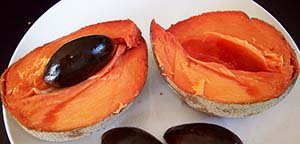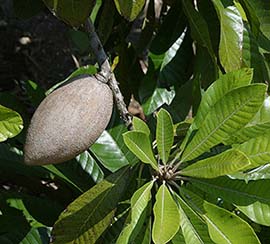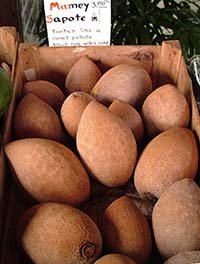Mamey Sapote Nutrition facts
Mamey sapote is a delicious tropical fruit, closely related to sapodilla (sapota). The plant is a medium-sized fruiting tree native to lowland forests of Central America.
Mamey is a medium-sized tropical, fruiting tree belonging to the family of Sapotaceae, in the genus: Pouteria. Some of the common names are Red sapote, mamey colorado, marmalade plum, etc. Scientific name: Pouteria sapota.
 |
| Mamey fruit, fruit cut section. Note for the vibraant pulp color and glossy dark brown seed. (Photo courtesy by Eric Bronson) |
<
Pouteria sapota, like other Sapotaceae plants, features an erect, thick central trunk and a few large limbs. Most trees shed most of their leaves in late winter or spring, but new shoots appear rapidly. The fruit is cultivated in other tropical countries such as Australia, the US, Philippines, Indonesia, and Malaysia.
 |
| Red sapote on a Pouteria sapota plant. (Photo courtesy by Malcom Mannners) |
After about 6-7 years of plantation, the tree bears small, whitish flowers which develop into oblong-shaped fruits. The fruit is a large berry, ovoid to ellipsoid in shape, with an attached calyx at the base. The fruit measures about 6 to 10 cm in diameter and 8 to 15 cm in length. Its outer skin is rough, leathery, and thick with a russet brown, somewhat scurfy surface as in sapodilla.
On the inside, the pulp of ripe fruits is soft, finely granular, salmon pink, deep-orange, or reddish-brown in color. The flesh is a sweet, somewhat custardy flavor. The fruit contains a single, hard, glossy, elliptical seed at its center. Mamey fruit weighs ranges from 300 grams to as large as 2.5 kg.
10 Surprising Health Benefits of Mamey sapote
-
Mamey sapote relatively carries more calories than many other tropical fruits like banana, jackfruit, and its close family member sapodilla 100 g of fresh fruit holds 124 calories.
- Mamey sapote is composed of soft, easily digestible pulp made up of simple sugars like fructose and sucrose. It is one of the foods that can instantly replenish energy and revitalize the body.
It is also one of the recommended supplement foods included in the treatment plan for under-nourished children and low body weight (BMI) people to regain weight and strength.
Mamey fruit is an excellent source of dietary fiber (5.4 g/100g), which makes it a good bulk laxative. Unlike in most leafy vegetables, mamey fruit fiber composes soluble fibers which help in smoother bowel movements and work to protect colon mucosa from bacteria and cancer-causing toxins.
Its pulp carries several polyphenolic antioxidant compounds like tannin. Tannins are a composite family of naturally occurring polyphenols.
Research studies suggest that tannins possess astringent properties, and are shown to have potential anti-inflammatory, antiviral, antibacterial, and anti-parasitic effects. Hence, these compounds may find useful applications in traditional medicines such as antidiarrheal, hemostatic (stops bleeding), and as a remedy for hemorrhoids.
Moreover, the anti-inflammatory actions of tannins are found helpful in the treatment of reflux esophagitis (GER), erosive gastritis, enteritis, and irritating bowel disorders. Some other fruits that also rich in tannins include pomegranate, persimmon, and grapes.
Mamey sapote holds some of the well-known antioxidant vitamins like vitamin-C at higher proportions than its cousin sapodilla. Fresh mamey has 24 mg or 38% of the recommended daily intake per 100 g of fruit. Consumption of foods rich in vitamin C helps the human body attain immunity against viral infectious agents and helps scavenge harmful oxygen free radicals.
Additionally, it contains several other health-promoting flavonoid poly-phenolic antioxidants such as lycopene, lutein, zeaxanthin, and β-carotenes in good concentrations. Together, these compounds help act as protective scavengers against oxygen-derived free radicals and reactive oxygen species (ROS) that play a role in aging and various disease processes.
Mamey (Red sapote) is better source of vitamin-B6 (pyridoxine) and niacin (B-3) than sapodilla. It provides about 55% and 9% against just 3% and 1% of the daily recommended allowance of sapodilla per 100 g. Pyridoxine is an essential B-complex vitamin that has a beneficial role in the treatment of neuritis, and anemia.
Further, vitamin B-6 helps decrease homocysteine levels within the human body. Homocysteine is one of the triggering factors in coronary artery disease (CHD) and stroke episodes.
Fresh ripe red sapote has higher levels of potassium than sapodilla (454 mg vs. 193 mg). Further, its mineral and other B-complex group of vitamin composition is also superior to sapodilla. It holds more copper, iron, and vitamins like folate, riboflavin, and pantothenic acid than sapodilla. These compounds are essential for optimal health as they are involved in various metabolic processes in the body as cofactors for the enzymes.
| Principle | Nutrient Value | Percent of RDA |
|---|---|---|
| Energy | 124 Kcal | 6% |
| Carbohydrates | 32.10 g | 24.5% |
| Protein | 1.45 g | 3% |
| Total Fat | 0.46 g | 2% |
| Cholesterol | 0 mg | 0% |
| Dietary Fiber | 5.4 g | 14% |
| Vitamins | ||
| Folates | 7 µg | 2% |
| Niacin | 1.432 mg | 9% |
| Pantothenic acid | 0.397 mg | 8% |
| Pyridoxine | 0.720 mg | 55% |
| Riboflavin | 0.116 mg | 9% |
| Thiamin | 0.013 mg | 1% |
| Vitamin A | 143 IU | 5% |
| Vitamin C | 23 mg | 38% |
| Electrolytes | ||
| Sodium | 7 mg | 0.5% |
| Potassium | 454 mg | 10% |
| Minerals | ||
| Calcium | 18 mg | 2% |
| Copper | 0.213 mg | 27% |
| Iron | 0.78 mg | 10% |
| Magnesium | 11 mg | 3% |
| Phosphorous | 26 mg | 4% |
| Zinc | 0.19 µg | 1.8% | Phyto-nutrients |
| Carotene-β | 82 μg | -- |
| Leutin-Zeaxanthin | 204 μg | -- |
| Lycopene | 199 μmg | -- |
Selection and storage
Several cultivars of mamey sapote hit the market all round the season. Normally, they are imported into the US. Harvesting is usually done manually by gently plucking/cutting with clippers.
Only mature fruits continue to ripen after their harvest and become edible. Therefore, their maturity is adjudged by scratching the fruit's surface to make sure whether the skin is ''not green'' underneath the scruff.
 |
| Sapota fruits. Note for rusty gray raw fruits. (Photo courtesy by Mark) |
In the markets, buy fresh mamey with smooth, intact skin and without surface cuts/cracks, bruises, or wrinkles. Once ripened, the fruit just yields to gentle thumb pressure.
As in other Sapotaceae members, mamey too must be kept at room temperature for 4 to 7 days to ripen. The firm, ripe fruits can keep well for several days in the home refrigerator and if set at 35° F, they can last for a few weeks.
Preparation and serving method
Only ripe mamey sapote is fit for consumption. Cut the fruit lengthwise into halves using a paring knife, then scoop the flesh using a spoon and discard its seed. It should be enjoyed without any additions in order to experience its unique flavor.
Here are some serving tips:
Fresh mamey sections are a great addition to fruit salads.
Mamey sapote milkshake/smoothie is a favorite drink.
It is also used in ice creams, jams, jellies, preserves, cakes, pies, etc.
Safety profile
Being one of the members in the Sapotaceae family of tropical fruits, mamey sapote features milky sap from its leaves and immature fruits.
The sap is composed of astringent compounds like tannins. These compounds are particularly concentrated in the raw mamey fruits which gives them an intensely bitter taste.
Consumption of raw, unripe mamey could result in raw sensation in the mouth and throat, mouth ulcers, swelling of throat mucosa, and breathing difficulty, especially in children. (Medical disclaimer).
≻≻-Back to Sapodilla (sapota).
≻≻-Back to Fruits from Mamey sapote. Visit here for an impressive list of all varieties of fruits with complete illustrations of their nutrition facts and health benefits.
≻≻-Back to Home page.
Further Resources: